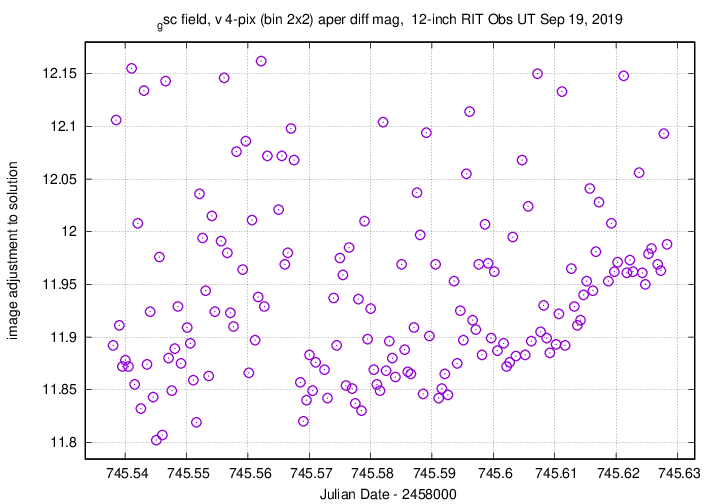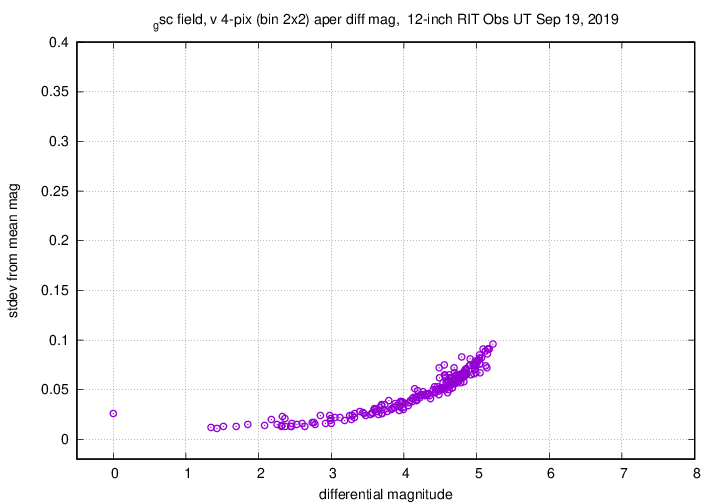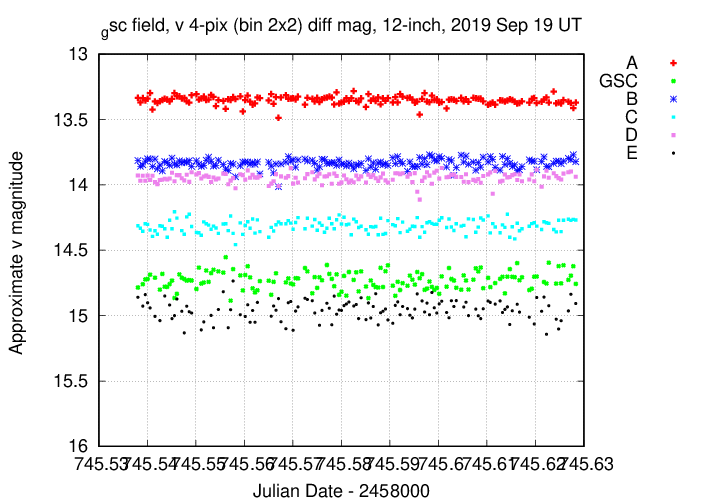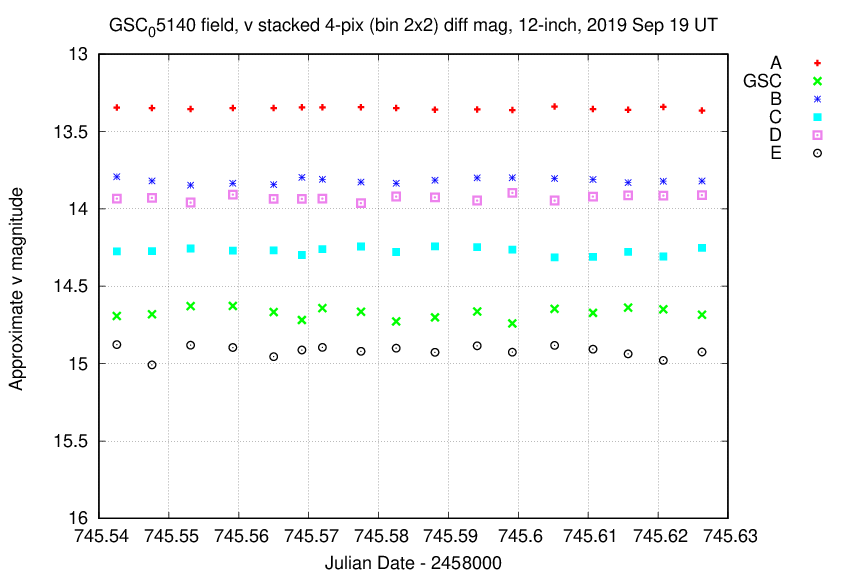
On the night of Sep 18/19, 2019, through dark skies but cirrus-y skies, I acquired a set of observations of the symbiotic star GSC 05140-03255. AAVSO Alert Notice 681 requested observations of this symbiotic star system over timescales of a few hours, so I decided to give it a try.
Spoiler alert: I detected no variations, and the noise isn't much smaller than the expected changes, so I won't be trying this one again.
As described in AAVSO Alert Notice 681
Further to AAVSO Alert Notices 632 and 650, Mx. Adrian Lucy and Dr. Jeno Sokoloski (Columbia University) are requesting more AAVSO photometry in support of a continuing search for new symbiotic stars (see Lucy et al. 2019, https://iopscience.iop.org/article/10.3847/2515-5172/aaf71c). They provide the information and observing parameters below."Here we add 7 new candidates that emerged as high-priority emission line objects from a June spectroscopy run at the SAAO 1.9m or from previous observing runs, and which exhibit tentative evidence of minutes-timescale variability in SkyMapper u band survey photometry.
"In the AAVSO observations, we are looking for flickering above 0.1 mag on timescales of minutes to hours in candidate symbiotic stars, a signature of mass transfer sometimes obscured by the large luminosity of the companion red giant."
The main setup was:
Notes from the night:
The object is located at
RA = 19:05:48.04 Dec = -06:05:49.5
A chart of the field is shown below. The size of the chart is about 19 by 18 arcminutes.

I've marked the location of several comparison stars, which also appear in light curves below. All these stars appear in the AAVSO chart X24786GJ.
star AAVSO B V ---------------------------------------------------- A 000-BNG-662 14.669 13.350 ----------------------------------------------------
I ran the camera at -20 C. Nothing out of the ordinary.

The sky value shows that the sky was free of clouds. The sky value increases as the field sets in the west, and the airmass rises.

Here's a record of the telescope's drift.

The number of objects detected. It drops at the end of the run due to extinction at higher airmass.

I used an aperture with radius 4.0 pixels tonight.

I discarded images which had obvious trailed stellar images, and also images which were outliers in the "image adjustment" plot. (discarded a total of 15 of the 179 raw images).

Using aperture photometry with a radius of 4 pixels (binned 2x2, each pixel is 1.34 arcsec, so a radius of 5.4 arcsec), I measured the instrumental magnitudes of a number of reference stars and the target. Following the procedures outlined by Kent Honeycutt's article on inhomogeneous ensemble photometry, I used all stars available in each image to define a reference frame, and measured each star against this frame.
Sigma-vs-mag plots show that the floor was about 0.012 mag overall. The target, at instrumental mag 4.767, does not stand out from its neighbors.

Here are light curves of the variable and the field stars.

I used the AAVSO value for the V-band magnitude of star "A" to shift the ensemble magnitudes to the standard V-band scale.
Since the light curve is so noisy, I tried co-adding sets of 10 images (not including trailed or otherwise bad ones). The result is less noisy -- the noise floor at the bright end decreases from 0.012 to 0.008 mag -- but the target again looks as constant as other stars of similar brightness.

You can download my measurements (of the original 30-second images, not the stacked one) below. A copy of the header of the file is shown to explain the format. I've submitted these measurements to the AAVSO.
# Measurements of GSC_05140-03255 made at RIT Obs, UT 2019 Sep 19, # in good conditions, # by Michael Richmond, # using Meade 12-inch LX200 and ATIK 11000. # Exposures 30 seconds long, V filter. # Tabulated times are midexposure (FITS header time - half exposure length) # and accurate only to +/- 1 second (??). # 'mag' is a differential magnitude based on ensemble photometry # using a circular aperture of radius 4 pix = 5.3 arcseconds. # which has been shifted so AAVSO 000-BNG-662 has mag=13.35 # which is its V-band magnitude according to AAVSO. # # UT_day JD HJD mag uncert Sep19.03802 2458745.53802 2458745.54006 14.785 0.066 Sep19.03903 2458745.53903 2458745.54107 14.760 0.065 Sep19.03954 2458745.53954 2458745.54158 14.723 0.062
Last modified 9/19/2019 by MWR.